In this Buyers Guide, you will find five of the Best 20×80 Binoculars For Astronomy.
And you’re going to want to.
Using a pair of astronomical binoculars is a brilliant way to start observing the sky.
With a wide field of view, their ease of use, and portability, binoculars provide a great, if not a better alternative, to a telescope.
As an enthusiastic astronomer myself, despite owning several telescopes I routinely use my binoculars to observe the sky.
I’ve come to realize that once you decide to invest in a good pair of astronomical binoculars, you’ll likely never stop using them.
Well, it is in my case!
Binoculars are a very versatile piece of equipment and are great for taking with you on the go and for providing crisp, clear views of the planets and stars in the sky.
This is following countless hours of research, review, and comparison.
In the table below you can quickly find the binoculars recommended.
I will then move on to provide some key information on what to look for in a good pair, the advantages, and how to make a decision.
Best 20×80 Binoculars For Astronomy








20×80 Bincoluar Details
** Note: All of the binoculars recommended below can be used by regular glasses/sunglasses users **
Celestron SkyMaster Pro 20×80 High Power Astronomy Binoculars (Editors Choice)
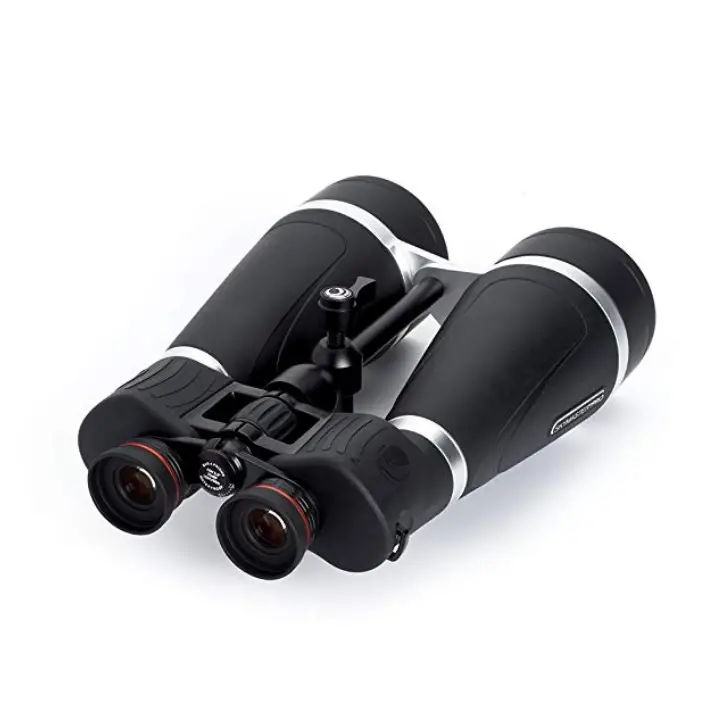
Field of View: 3.2°
Lens Coating: Fully Multi-Coated
Eye Relief: 15.5mm
Weight: 5 lbs
Tripod Adapter: Yes
Summary:
The standout winner. The High Power Version of the SkyMaster series by Celestron.
These are a truly premium pair of binoculars that come with some extra functionality to the standard SkyMaster pair (found below).
Perhaps the standout feature is the detachable RSR rail that enables you to install a Finderscope to your binoculars.
A Finderscope can be a really great way to identify and isolate individual planets and stars and these binoculars give you this option.
Plus the attachment itself can be removed so it’s not a clunky waste of space if you decide not to use it.
Secondly, they are better constructed and more resilient than the standard pair; being rubber-armored which improves the ergonomics and your ability to protect them when using them to observe the sky.
They are fully waterproof but have also been purged with nitrogen to give them that added level of protection from wet conditions.
Just like any binocular in the SkyMaster range, these are multi-coated and they come with a tripod adapter attachment.
You also get a lot more extra components included with this pair, like objective lens caps, rainguard, neck strap, lens cloth, and instruction manual.
In terms of performance, you will be able to observe the stars and planets with great clarity due to the magnification and impressive field of view.
Pros
- Can be used for both Astronomical and Land Viewing (scenic views, yachts and ships etc).
- Easily focusable with one center knob.
- Detachable RSR rail that enables you to attach a Finderscope (or take off the attachment if not needed)
- Very well constructed where few users report issues with collimation.
- Waterproof and nitrogen purged so they are protected in all weather conditions.
- Additional components included: objective lens caps, rain-guard, neck strap, lens cloth, and instruction manual.
Cons
- On the more expensive side compared to other binoculars on the market.
- SUPERIOR OPTICS, COATINGS, MATERIALS, AND CRAFTSMANSHIP: With large objective lenses, BaK-4 prisms, and fully multi-coated optics utilizing Celestron’s proprietary XLT coatings, the view through SkyMaster Pro is second to none at its price point.
- RSR "REFLEX SIGHT READY" RAIL: SkyMaster Pro's unique detachable RSR rail allows you to mount an optional red dot finderscope or other reflex sight. Pointing at astronomical or land-based targets with a binocular has never been easier.
- FULLY MULTI-COATED OPTICS: Every lens surface is coated multiple times with Celestron's unique XLT coatings to improve color and contrast and maximize brightness. You'll enjoy brighter and sharper images, even when lighting conditions are dim.
- DURABLE, WATERPROOF BODY: A rubber-armored, polycarbonate housing protects your binoculars from damage and stands up to the toughest weather conditions. They're also fully waterproof and nitrogen purged to prevent internal fogging of the lenses.
- UNBEATABLE WARRANTY & CUSTOMER SUPPORT: Buy with confidence from Celestron, a leading optics brand in California since 1960. Your purchase includes a Celestron Limited Lifetime US Warranty & US-based expert tech support.
Celestron SkyMaster 20×80 Astronomy Binoculars
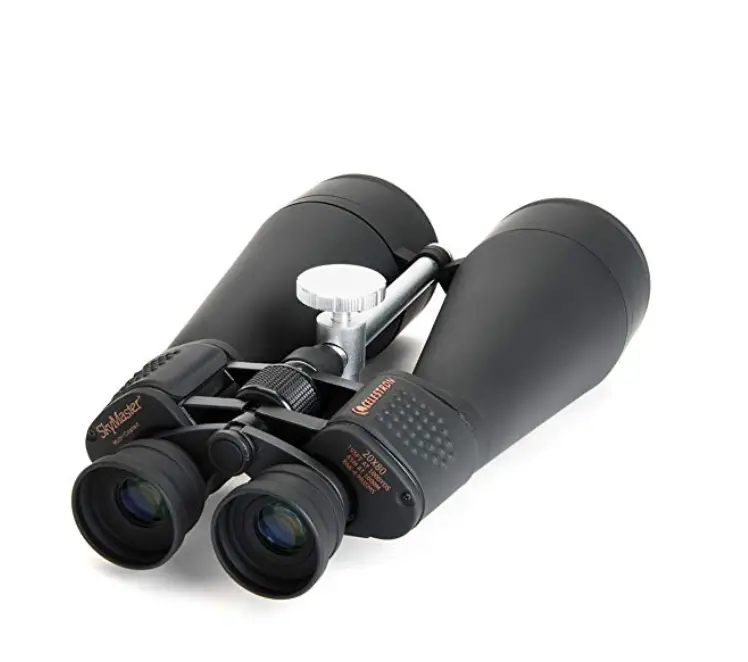
Field of View: 3.7°
Lens Coating: Fully Multi-Coated
Eye Relief: 18mm
Weight: 5.86 lbs
Tripod Adapter: Yes
Summary:
One of the most popular choices for binoculars on Amazon, the SkyMaster Series from Celestron offers 20x magnification in the body of 80mm objective lenses for a really affordable and incomparable price.
These are really high-quality and robust binoculars that are easy to work with and use, providing you with long-distance terrestrial viewing with comfort.
They have soft, rubber eyecups which make them extra comfortable, and the 18mm eye relief means that if you wear glasses you can fold down these eyecups for easier viewing.
They have multi-coated lenses which provide excellent light transmission meaning that they are great if you observe the sky in dark conditions (particularly good for rural areas).
I personally really like the protective rubber coating which enables you to grip them tightly and hold them comfortably.
Beyond this, they were designed with a Tripod in mind, and the binoculars have an Integrated Tripod Adapter that you can use to install them for a more stable viewing experience.
Providing razor-sharp views, these are an excellent pair of binoculars.
Pros
- A great bridge between price and optic quality.
- Rubber Eyecups and Rubber Coating make these very comfortable.
- Images are sharp, very bright, and clear when the air is cool,
- Wide field of view.
Cons
- Basic construction, considered inferior particularly when compared to the Pros,
- Have been known to have color separation, double imaging and collimation issues.
- POWERFUL 20X MAGNIFICATION: Giant astronomy binoculars feature massive 80mm objective lenses and powerful 20x magnification. These binoculars are ideal for long-distance viewing of land-based subjects or astronomical observing at night.
- INCLUDES TRIPOD ADAPTER: Stabilize your binocular for added comfort and shake-free views. Mount your 80mm SkyMaster binoculars on any traditional photographic tripod with the built-in tripod adapter.
- BRIGHT, SHARP VIEWS WITH BaK-4 PRISMS: The SkyMaster is a favorite among those who view in dim conditions near dawn and dusk or at night for astronomy. BaK-4 prisms maximize light throughput to your eye so you see brighter, more detailed images.
- DURABLE AND WATER-RESISTANT: A rubber-armored housing protects your binoculars from damage and provides a secure gripping surface. The water-resistant exterior stands up to tough conditions and unexpected rainy weather.
- UNBEATABLE WARRANTY & CUSTOMER SUPPORT: Buy with confidence from Celestron, a leading optics brand in California since 1960. Your purchase includes a Celestron Limited Lifetime US Warranty & US-based expert tech support.
Learn more: Celestron SkyMaster 20×80 Binoculars Review
Orion 51464 20×80 Astronomy Binoculars
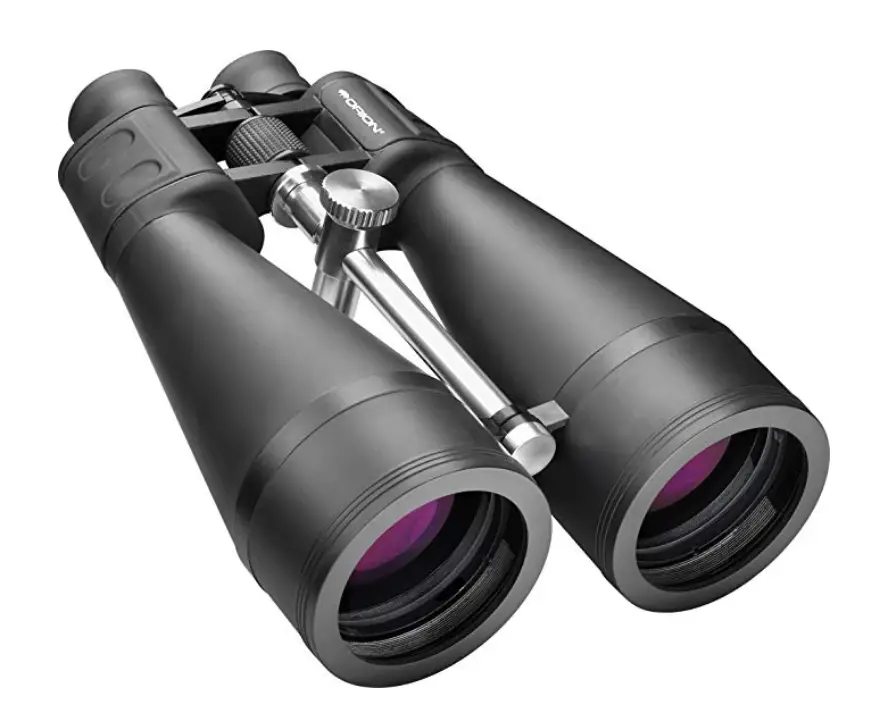
Field of View: 3.2°
Lens Coating: Fully Multi-Coated
Eye Relief: 17mm
Weight: 4.7 lbs
Tripod Adapter: Yes
Summary:
Orion is another formidable and well-respected manufacturer in the astronomy equipment space.
It comes as no surprise that their 20×80 binoculars make the list. The Orion binoculars are a great mix of price and quality.
They come with a great field of view, which is flat and very clear.
They are relatively light and compact despite punching the 20x magnification and 80mm of the aperture which gives you the power that you need.
Just like all of the featured binoculars in the list, these come with fully multi-coated optics giving you the much-needed improved light transmission.
It also comes with the Tripod Adapter if you are looking to attach it to a tripod when observing the sky.
Orion is keen to provide you with all the equipment you need to use them most effectively. So you also get a soft carry case and dust caps to protect the lenses.
Pros
- Solidy built and considered comfortable to handle.
- Fully multi-coated optics and BAK 4 Porro prisms. This enables you to obtain the maximum light exposure you need for clear, bright views
- Long 17mm eye relief for comfortable views – perfect if you wear glasses.
Cons
- Some have been known to be out of collimination upon arrival. In such instances, they will need replacing which takes time (although this will be done free of charge).
- Case and the dust covers are not the best. The dust covers are large and have been known to fall off. While the case offers protection its not easy to use and can be frustrating to work with.
- Big 20-power astronomy binoculars with huge 80mm aperture objective lenses provides bright, high-contrast views of the night sky with sharp resolution
- Giant 80mm lenses gobble up light for spectacular views of the Moon, planets, star clusters, and more!
- Fully multi-coated optics and BAK 4 porro prisms ensure maximum light throughput for bright, clear views
- Long 17mm eye relief for comfortable views - even while wearing eyeglasses!
- Includes built-in tripod adapter, soft carry case, and dust caps. Tripod use recommended
Gosky Skyview 20×80 Astronomy Binoculars
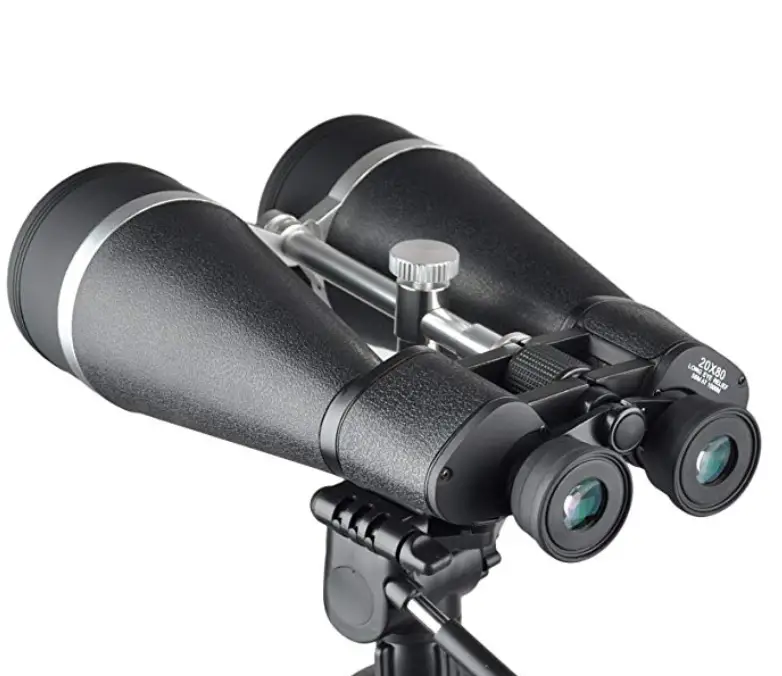
Field of View: 2.2°
Lens Coating: Fully Multi-Coated
Eye Relief: 15.4mm
Weight: 5 lbs
Tripod Adapter: Yes
Summary:
The Gosky SkyView 20×80 binoculars were not actually designed exclusively for astronomy alone. That does not mean that they should not be worthy of your consideration, because this is one of their many uses.
These binoculars feature excellent optics with Large Bak-4 Porro Prisms and Fully Multi-Coated 80mm lenses.
The result is that they deliver truly powerful performance and clear views when stargazing.
They were designed with an aluminum framework which makes them extra durable, and the rubber armor is there to aid the comfort.
In terms of protection, you also get a protective shield and a carrying case which is handy for taking these with you on the go. The protective shield is also great at preventing dust and moisture from collecting on the lenses if you attach them to a tripod.
Pros
- Aluminum Framework and Rubber Coating make these sturdy and durable.
- Protective Shield included which protects the binoculars from dust and moisture specifically when attached to a tripod. Also helps prevent stray light for better viewing.
Cons
- Smaller Eye Relief; so not as suitable if you were glasses compared to the other options.
- Field of View is smaller at 2.2°
- OUTSTANDING OPTICS — Large Bak-4 Roof Prisms and Fully Multi-coated Optics - guarentee the key elements of an optical device, make your view brighter, clearer and deliver crisp images
- EXTREMELY LARGE APERTURE VIEW — 80mm large objective lens maximizes light transmission for superior brightness and vivid images even in low-light conditions and also provides large view range
- COMFORTABLE TO USE — Not like spotting scopes or telescopes, just look through the binoculars with your two eagle eyes open. Specially designed for Bird Watching, Sightseeing, Shooting and Stargazing
- DURABLE CONSTRUCTION — Durable aluminum polycarbonate framework and rubber armor provide non-slip, shock-proof grip and ergonomics external protection - enable the binoculars to withstand the toughest weather conditions
- FULL RANGE OF ACCESSORIES — Smartphone digiscoping adapter enables you to take photos and videos of what you have observed. Carrying case, eyepiece and lens protection covers, cleaning cloth make you more convenient to carry and maintain
Why Astronomical Binoculars?
The common mistake in astronomy is opting straight for a telescope.
Whilst they are excellent for viewing the night sky, there is a steep learning curve and they require knowledge and understanding to set up and use.
This is not the case with binoculars.
Binoculars have lower magnification and a wider field of scope, than a telescope, which may not sound like a good thing, in fact, it is.
This ensures you can observe the night sky and discover objects a lot more easily (you are not as ‘zoomed in’ if you like).
Binoculars are considerably cheaper than a telescope, so it makes sense to get a pair, enjoy stargazing and then progress onto a telescope later if you feel inclined.
There are actually a lot of astronomers who continue to use their binoculars ahead of their telescope when this time comes or use them just as much and just as often even with this more powerful equipment at their disposal.
Advantages of Astronomical Binoculars
I will know quickly go over the advantages of using a good pair of binoculars before I turn to how to find and choose the best pair for you.
When observing the sky, these are the advantages you will find when using binoculars over a telescope:
- You can use both of your eyes together. This is a lot more comfortable and you will find it a lot easier to observe objects
- Scientific studies have shown that you are likely to see a better, more detailed image when using both eyes together. This is just what you want when observing the sky.
- Binoculars come with what’s known as a “wider field of view” than what you get with a telescope, This basically means that you will be able to see more of the sky at any one time with them. You will also be able to move around the sky and isolate things more easily.
- Telescopes sometimes appear to show upside-down views of the sky, and this can be difficult to work with. Instead, binoculars will always align with the corrected field of view, so this complication will never arise when using them.
- Binoculars do not require any setup, management, or storage.
- Binoculars work equally as well in the day as they do in the night. A good pair of binoculars is considerably cheaper than a bad, or low-spec telescope.
- Binoculars come with everything you need. Everything is built-in. Telescopes ton the other hand require investment in further components like eyepieces, a mount, filters, and weights, etc,
- A pair of Binoculars are very easy to use and can be used by young children as well as adults.
How To Choose The Right Astronomical Binoculars
Astronomical Binoculars follow the same conventions and logic as any old regular set of binoculars. As such the two main areas to focus on are magnification and the objective lens size.
So if you are here you are looking for 20x80s.
This effectively means they have 20x magnification (objects look 20x their normal size) and 80mm objective lenses (the amount of light they pick up).
Remember, more light means more visibility into the night sky.
The light collection is one of the most important elements of a piece of astronomical equipment, so choosing a pair of 20x80s (some of the higher light-collecting binoculars available) is a really sensible choice.
The secret to choosing your ideal pair of binoculars is finding the balance between magnification and lens size.
If you get this right you will see clear, bright, and stable images when looking into the sky. In my experience, 20×80 is an ideal ratio.
Do You Want To Use A Tripod?
One of the factors you should consider when buying a pair of astronomical binoculars is whether you want to use a tripod.
These are an effective way to stabilize and take the effort away from holding your binoculars to the sky.
Most pairs of binoculars come with an attachment – it’s just a simple screw fix that you will need to turn to mount them on.
However, there will be limitations on the standard fixing like not being able to point higher than roughly 30° above the horizon.
The better pairs of binoculars come with a Tripod Adapter, like all featured in this list, which give you the ability to extend beyond this.
Tripods are great for taking the weight of the binoculars and leaving you to enjoy the experience of stargazing.
Your views will be steadier and clearer so this is something you should consider.
Anti-Reflective Coatings
Another thing to look out for with binocular specifications is whether the binoculars come with Anti-Reflective Coatings.
Glass naturally reflects light, so not all of the light will make its way through.
What this means for you is that you see less and in lower quality.
To alleviate this issue, the best binoculars come with an anti-reflective coating on the glass elements of the binocular.
The better the quality and more layers of coating applied, the better. You will see objects in the sky more brightly and clearly.
Consider that more coatings typically result in higher costs! Some of the anti-reflective coatings can be seen on astronomical binoculars – their lenses may be colored.
When looking at the anti-reflective coatings on your binoculars, you should look out for the below (From best to the lowest quality)
- Fully Multicoated – All glass surfaces have multiple coatings and it is the best kind, resulting in light transmission of 90-95% for bright, sharp and contrast images.
- Multicoated – At least one of the major optical elements in a fully-coated binocular has multiple coatings of anti-reflective compounds on at least one surface.
- Fully Coated – All lenses and glass surfaces have a coating layer. For binoculars, this includes the long side of the prism.
Field of View
One final thing to consider is the ‘Field of View’. This is another important measurement that you are going to want to take to look at.
What is this exactly? It measures how much of the sky a pair of binoculars will show you when you look through them.
Despite higher magnification tending to mean a smaller field of view, the different optics of a pair of binoculars mean that two different pairs of 20x80s can have two different fields of view.
The field-of-view measurement is typically provided by an angle in degrees or as a width in feet of the image at 1000 yards.
To help you understand the measurements, a pair of binoculars with a 3.6° field of view can essentially show you an area of the sky that equals a circle with a diameter of 3.6°. So the bigger the number the more you can see.
Final Words
So, you should now have everything you need to help choose your astronomical binoculars to observe the sky and all of its many wonders.
In summary, I’ve looked at what to look for in a pair of binoculars and then reviewed the best five that meet this criterion.
For me, the absolute best pair, are the Celestron SkyMaster Pros.
Although, if you are on a budget and are willing to balances cost and performance, opt for the standard Celestron SkyMasters.
I also recommend that if possible, you consider an accidental protection plan.
Binoculars are temperamental pieces of equipment that can damage and break if you do not take utmost care of them.
Having a protection plan can ease your concerns and ensure that you get a new pair sent out to you quickly if anything was to happen.
Whichever pair you choose, I hope you enjoy the sights and the stars that are now possible!
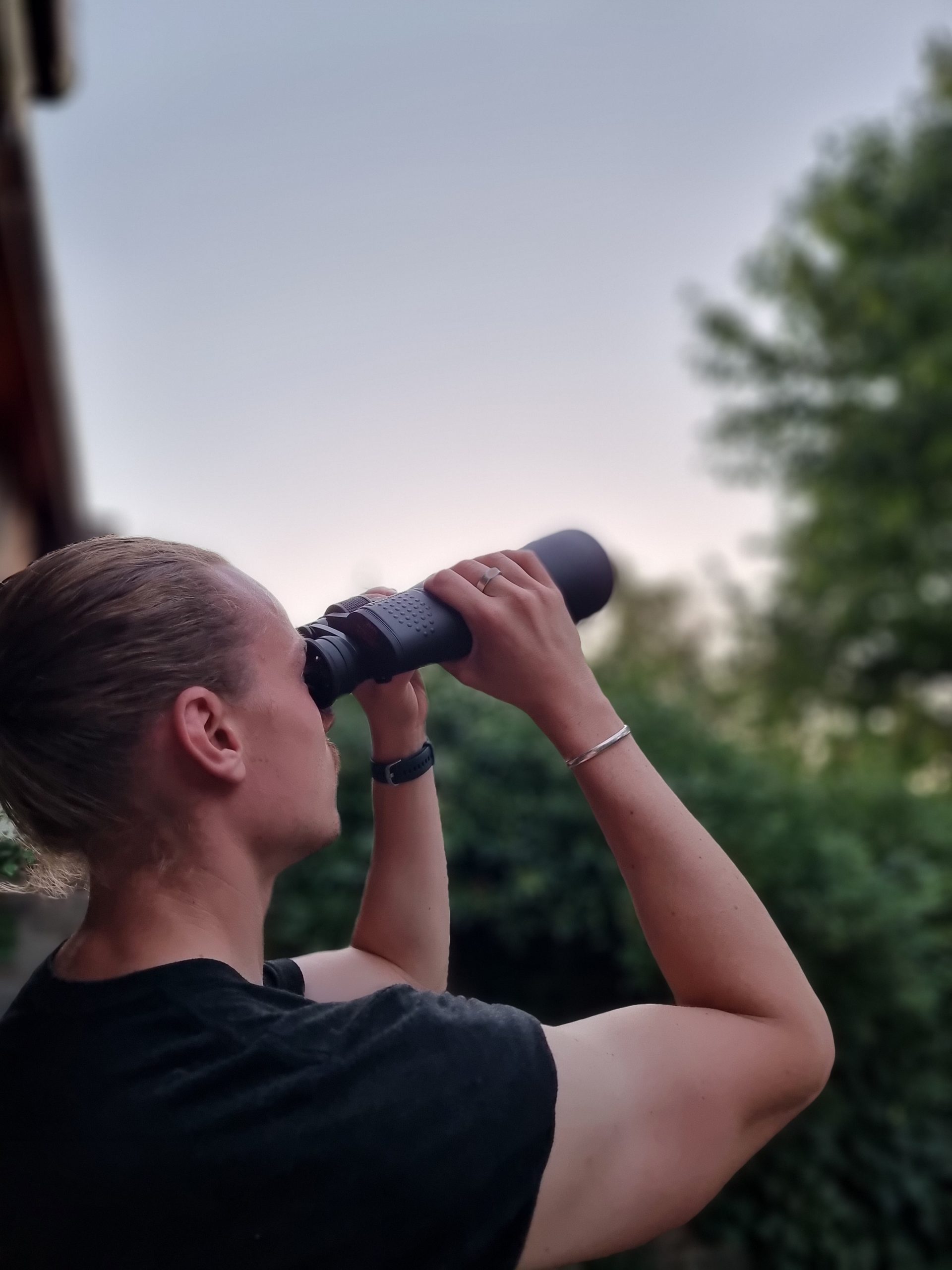
Hey, my name is Jeremy. I’m a passionate and seasoned astronomer who loves nothing more than observing the night sky. I also love researching, learning, and writing all things Space and the Universe. I created Astronomy Scope to share my knowledge, experience, suggestions, and recommendations of what I have learned along the way while helping anyone to get into and maximize their enjoyment of the hobby.
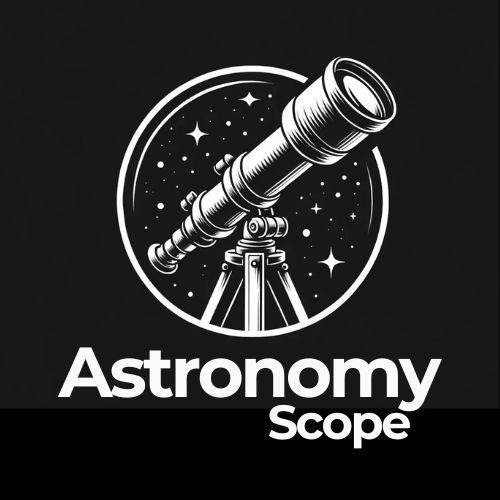
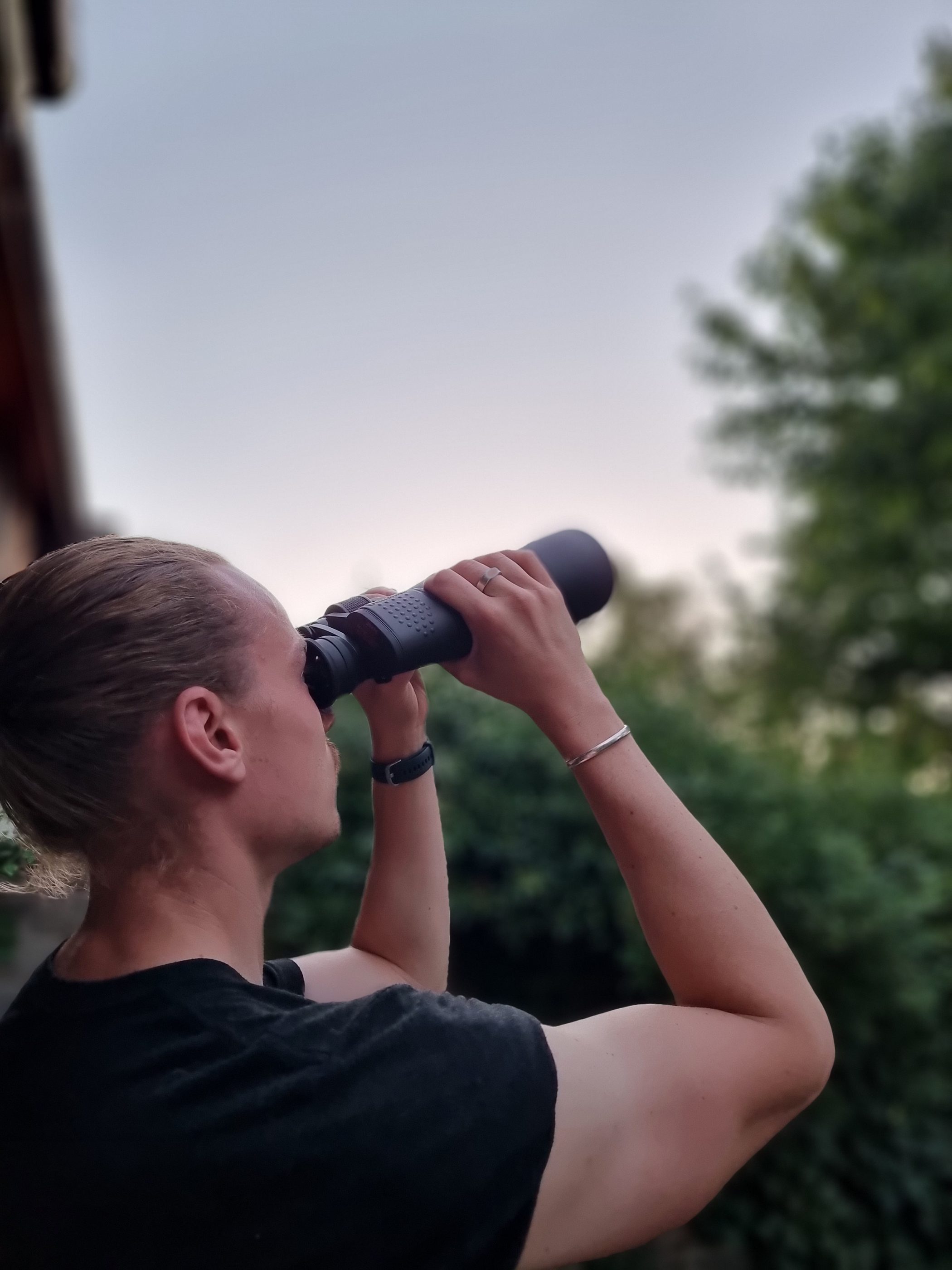
good stuff! im fairly new to stargazing, and the telescopes do seem a bit daunting. i will def be going with the editors choice.
do you need a filter to better see the moon, it being so bright?
Hello Sam,
The surface brightness is proportional to the aperture and inversely proportional to the magnification … 80/20 = 4. This may or may not be too bright depending on your preferences.
The easiest solution is to just keep observing the moon with your Binoculars and you will notice that after a few ibserving sessions your eyes will adapt and get used to the glare.
Thankfully moonlight can not and does not cause any lasting damage to your eyes. However after observing the bright moon it may require some time for your eyes to become dark adapted again and you can start observing other celestial objects.
However you could get a filter if you wanted to prevent this issue.
Aright cool. What about solar filters? And have you seen the sun through filters are on binoculars?
Youre going to need Solar Filters if you want to observe the sun. Otherwise you can cause quite some damage to your eyes.
Having said that it can be really fun to observe and I have some Solar Filters for my binocs.
I have the Orion 4.30″ ID Set of Orion Binocular Solar Filters (which fit 20x80s). Suggest you take a look at them if you want to observe the sun or protect your eyes when quickly scanning the sky.
The best moon filter? Light!
Just leave a patio or garden light on when observing the moon and you’re all set with its apparent brightness. I got this very useful tip from some Cloudy Nights astronomy forum’s members and have been a happy bunny ever since, not having to try to Rob to give to Peter and spend money on filters and in hindsight, you don’t actually have to.
After all, on nights of moon observing, any other object you may possibly find useful to observe (double stars, planets and other SS objects) don’t require any darkness adaptation – let alone the moon itself!
So, give your retina’s rods a rest and leave those DSOs (and ad hoc darkness adaptation) for those moonless nights and enjoy the view!
Thanks for this Scott. Great advice and tip!